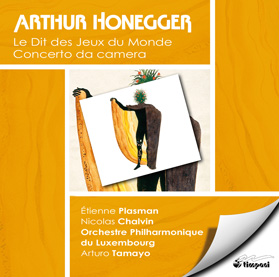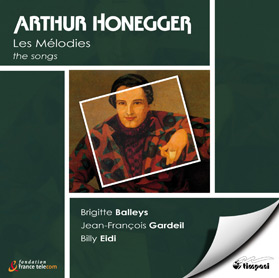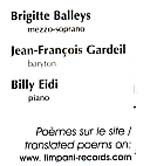|
timpani-overview
This French niche CD label has been brought to our attention by its UK Distributor, Discovery-Records [mailto:webmanager@discovery-records.com].
Its catalogue is alluring, and the sample CDs we have received to consider are all well recorded and with presentation of high quality, save for one reservation, the omission of texts and translations for the vocal music...
| |
|
|
 |
|
LILI BOULANGER Clairières dans le ciel; Trois Morceaux pour piano; Quatre Mélodies
Jean Paul Fouchécourt, ténor
Sonia de Beaufort, mezzo-soprano (17-20)
Alain Jacquon, piano
timpani 1C1128
A gifted musician who was doomed to become bedridden and to an early death at 24, and knew it.
Her sister, the famous pedagogue Nadia, gave up composing to promote the works of her young sister. These are superb songs, introduced by the great Belgian musicologist Harry Halbreich in detailed analysis for which he is famous. Lily Boulanger developed a musical language with "a changing and refined complex harmony, soetimes modal at others chromatic, with surprising bitonal progressions". Some of her songs are of heart-wrenching intensity.
timpani states that the texts and translations, which are indispensable, are available on their website, but I have not succeeded in accessing them there. However, help is at hand via Emily Ezust's wonderful website, with all the poems available together with translations by Faithe Cormier at http://www.recmusic.org/lieder/assemble_texts.html?SongCycleId=85
Strongly recommended, and aspiring singers of French Mélodie should consider adding them to their repertoires.
|


|
|
HONEGGER Concerto da camera; Le Dit des jeux du monde
Etienne Plasman, flûte
Nicolas Chalvin, cor anglais
Orchestre Philharmonique du Luxembourg
Arturo Tamayo, direction
timpani 1C1129
This orchestral disc has the double wind concerto, one of Honegger's loveliest late works- "one of the purest jewels he ever fashioned - - a more transparent, more concentrated sibling of the Fourth Symphony" (Harry Halbreich), coupled with a youthful master work of 1918, music for a whole evening "neither a ballet, nor an audio-visual poem, but a bit of each", "an unprecedented spectacle" to the stringent commissioning conditionsof which Honegger adapted himself with "eminently professional ease" (Halbriech). A major discovery, one of many by this prolific composer hardly known.
ARTHUR HONEGGER Mélodies (Intégrales)
1C1140 [78'19]
Likewise, and of equal value and greater potential accessability, are Honegger's 46 songs collected here. Halbreich's compendious notes run to seven close-printed pages, which leave us British poor linguists frustrated by the lack of texts with translations. Some are to be found on Ezust's The Lied and Art Song Texts Page, but that is really not good enough. 
The scope is hugely varied, with the last one, Mimaamaquim, "probably the greatest of Honegger's songs - - a pinnacle of his work with overwhelming emotion made authentic by its restraint" (Halbreich).
French-speakers should certainly acquire this disc to broaden their knowledge of the rich field of French song.
Peter Grahame Woolf
Note: I have just acquired the monumental biography of Arthur Honegger by Harry Halbreich; available from Amazon.com at a fraction of its proper price - totally recommended [Editor] |
|
|
CHABRIER – Complete Songs
Le Sentier somber; L'Île heureuse; Lied (de Banville); Sérénade; Chanson pour Jeanne; Couplet de Mariette; Le soldat du Roi; Que les amants ont de peines; L'Invitation au voyage; Lied (C. Mendès); Ronde gauloise; Chants d'oiseaux; Ballade des gros dindons; Les Cigales; Villanelle des petits canards; Pastorale des cochons roses; Adieux à Suzon; Sommation irrespectueuse; Tes yeux bleus; L'Enfant; Ruy Blas; Toutes les fleurs !; Credo d'amour
Agnes Mellon – soprano
Franck Leguerinel – baritone
Francoise Tillard – piano
Timpani 1C1144 [1997: 77 mins]
Mention the name Chabrier and his famous orchestral rhapsody Espana leaps immediately to mind, but Emmanuel Chabrier was far more than a one-hit composer. An unassuming and rather dumpy figure of a man, he moved freely in the artistic circles of late 19th century Paris, interested in music and literature and one of the first to appreciate the merits of the new “impressionist” school of painters.
Manet’s Un bar aux Folies Bergère hung on the wall above his piano, and he also owned paintings by Degas, Monet and Renoir. These then were the influences that surrounded him and helped to set the scene for his songs, for the most part setting texts of poets who were his friends and written for their mutual enjoyment.
There is nothing of the “polished for posterity” about Chabrier’s songs, but rather they have about them a disarming sense of spontaneity; they are quick witted and full of surprises - compassion and comedy counterbalance. The tenderness of songs such as Serenade and Tes yeux bleu never over-tips into sentimentality, and the group of animal songs (Villanelle of the little ducks; Ballad of the plump turkey cock, Pastorale of pink pigs) are charmingly affectionate.
The twenty-three songs in this compilation - whilst not quite complete - make a very satisfactory collection, and it is a great advantage to have two fine singers who are native French speakers accompanied by an excellent pianist.
The serious down-side of the package is the lack of texts and translations, and for these I would refer purchasers to the Hyperion web site where they can be found, together with Graham Johnson’s erudite notes, associated with the Chabrier volume Musique adorable CDA67133/4.
Serena Fenwick |
|
|
GABRIEL FAURÉ Mélodies
op. 51, 57, 58, 76, 83, 85, 87
and Deux Mélodies de 1906
Yann Beuron, ténor
Billy Eidi, piano
timpani 1C1162
This new collection from Beuron (a regular recording artist for timpani) sounds fine (to an English speaking listener) but the release is fatally flawed by the lack of translations of the poems, a regular complaint. What makes it particularly frustrating here is that the excellent notes are translated into perfect English by an English translator John Tyler Tuttle. Was he unable to exercise influence upon timpani?
Perhaps Timpani may be persuaded to put them onto their website (not for the first time of asking), which Naxos does when possible with their budget price releases.
I have found English versions of the Mélodies de Venise op. 58 (only) by Emily Ezust on her indispensible website, but on Hyperion's it is easy to access translations of many of these songs, together with Graham Johnson's "comprehensive notes, packed with information on each song and its cultural surround"For British collectors, THE HYPERION FRENCH SONGS EDITION is the clear recommendation.
Peter Grahame Woolf |
| |
|
|
|



